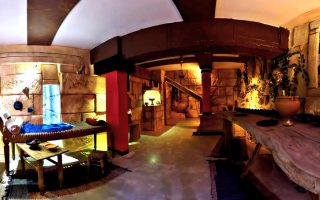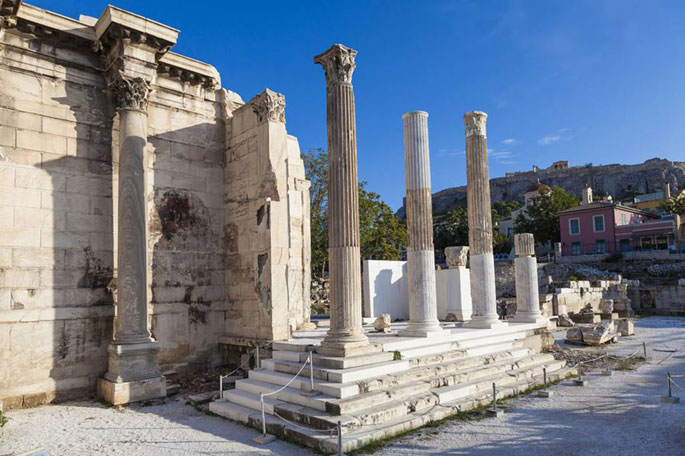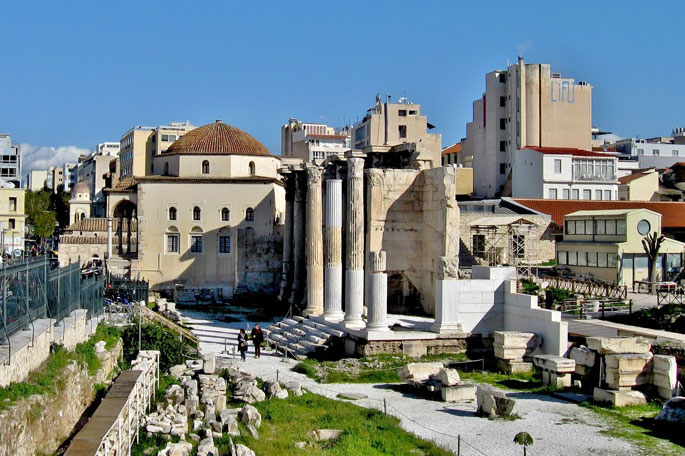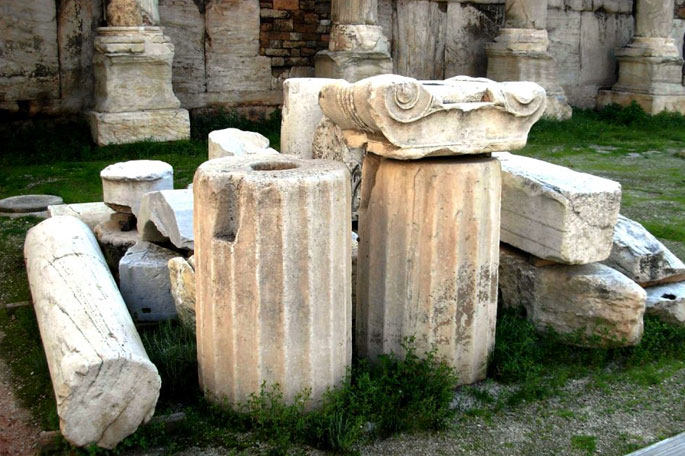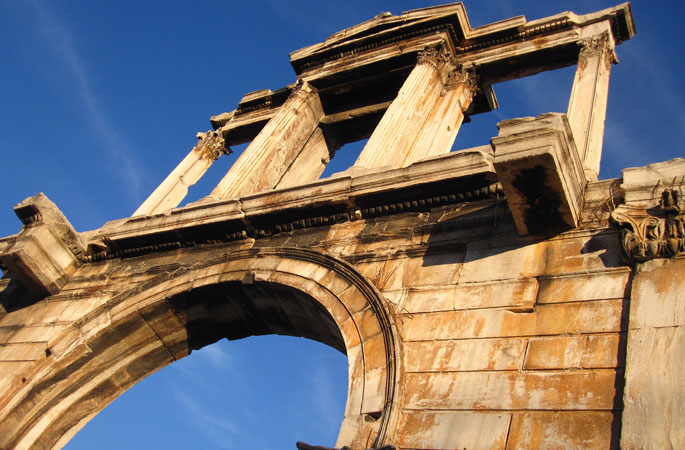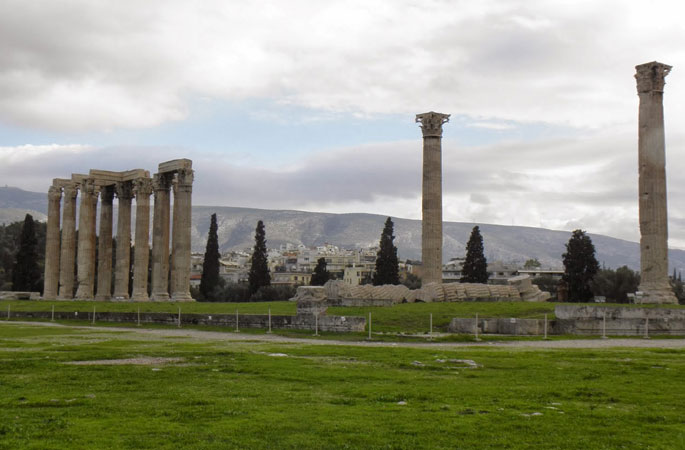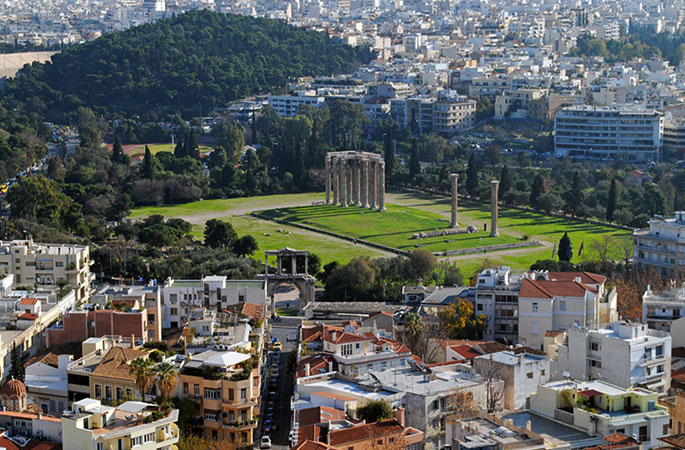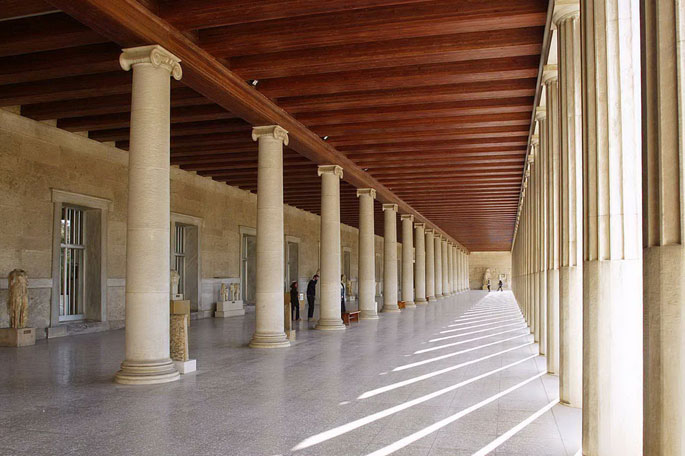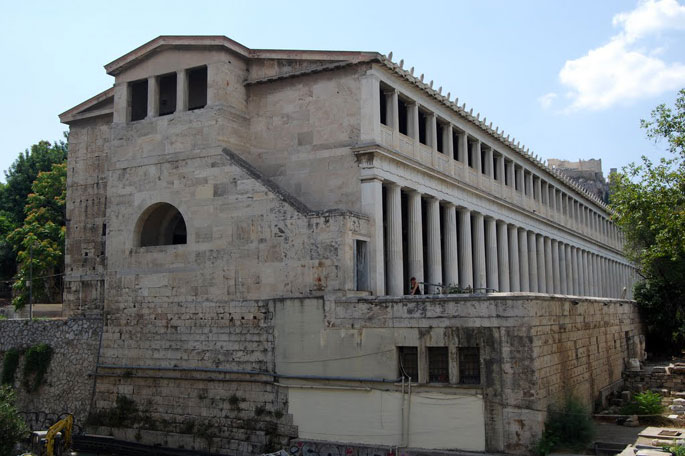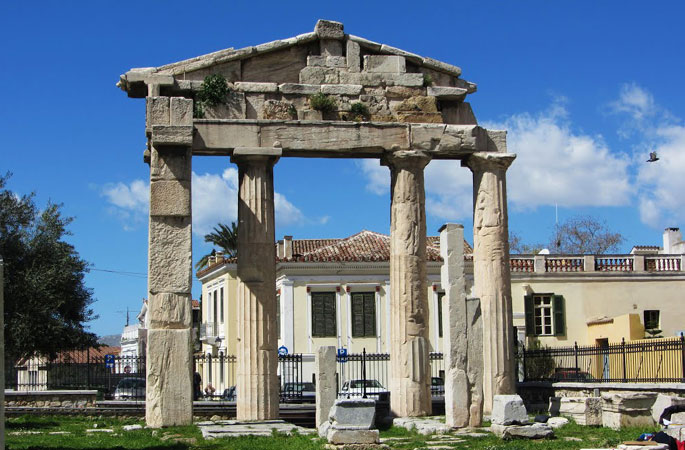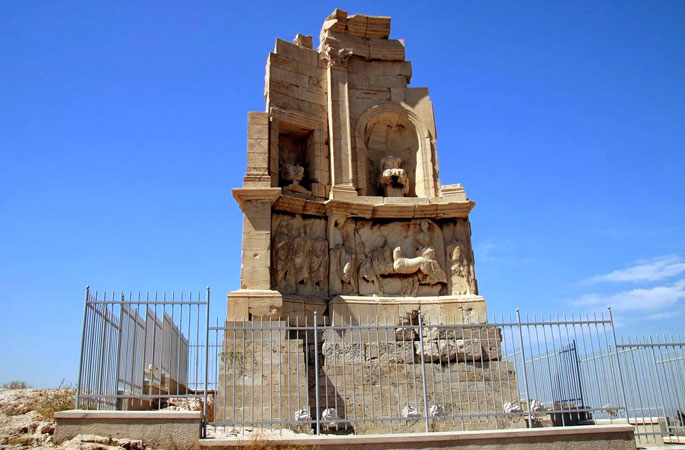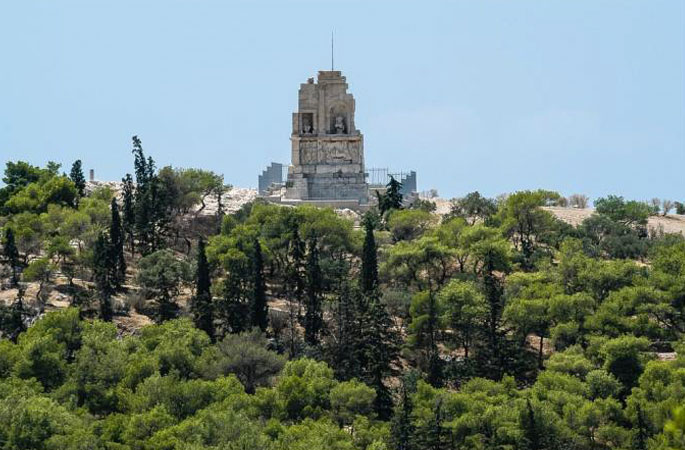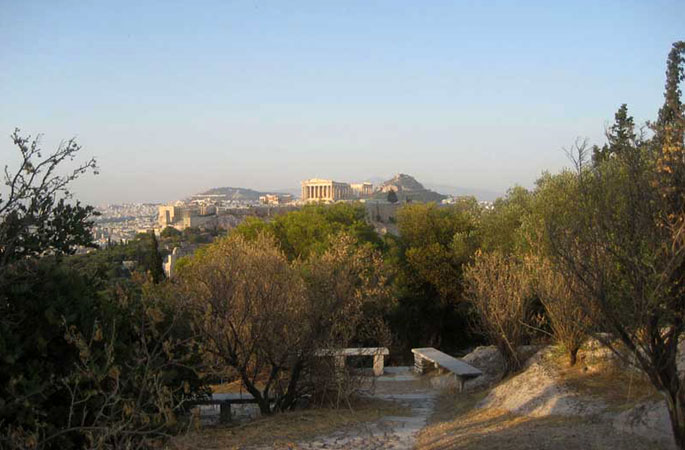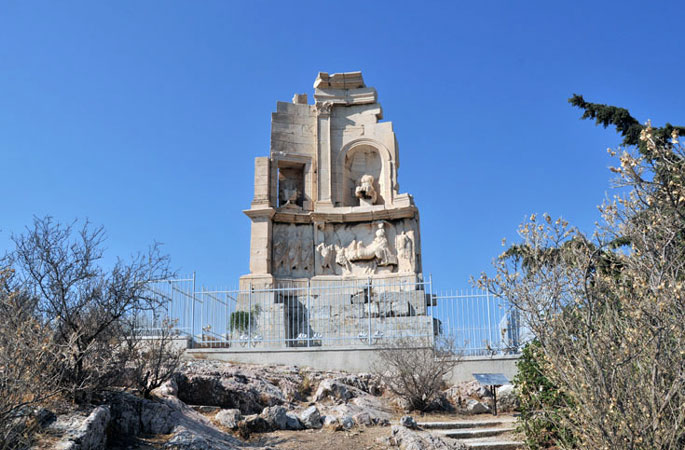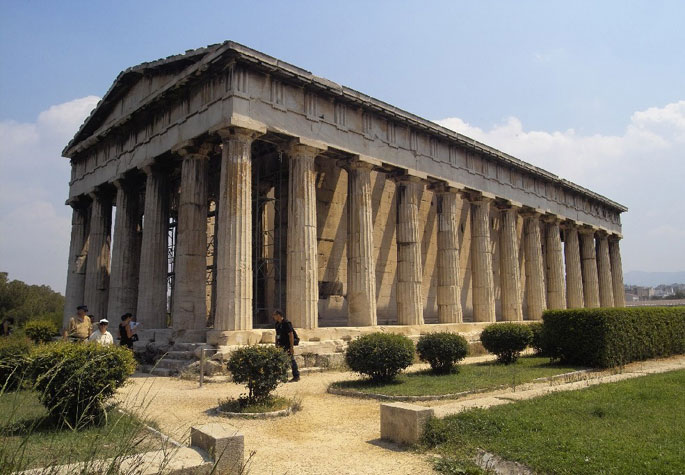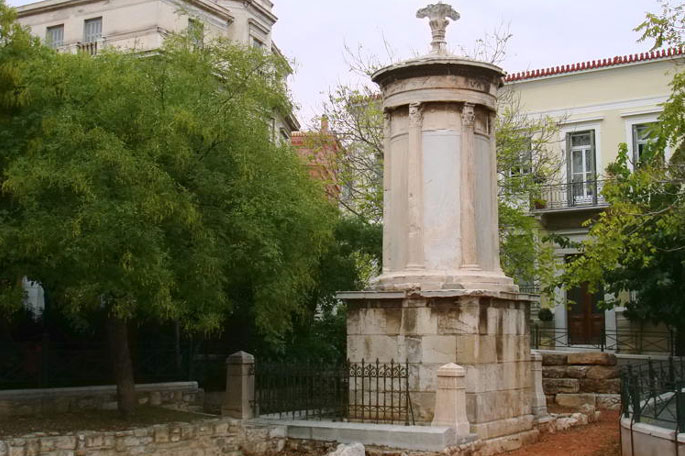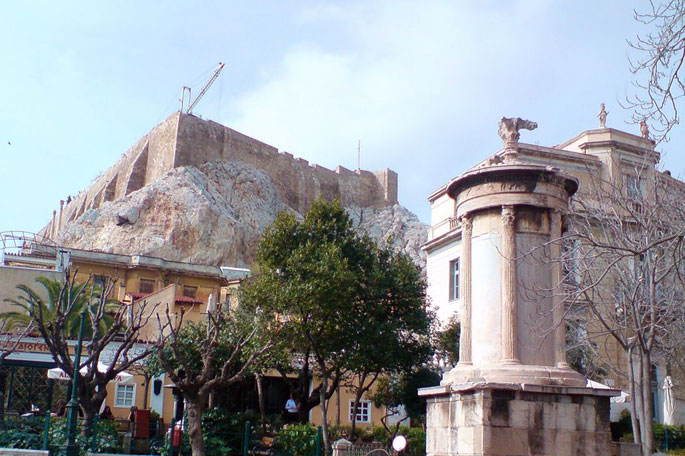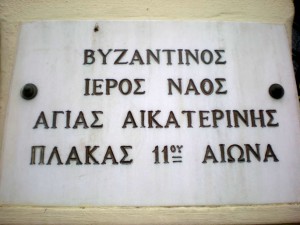 Located in Plaka, the Church of Ag. Aikaterini was built in the middle of the 11th Century, and is a domed, cross-in-quare, four-aisled complex. Experts of Byzantine history believe the church was dedicated to Ag. Theodoros, as indicated by the inscription on the marble column supporting the Altar.
Located in Plaka, the Church of Ag. Aikaterini was built in the middle of the 11th Century, and is a domed, cross-in-quare, four-aisled complex. Experts of Byzantine history believe the church was dedicated to Ag. Theodoros, as indicated by the inscription on the marble column supporting the Altar.
This is the old parish church of the Alikokos neighbourhood in Plaka, just opposite the choragic monument of Lysicrates, which, in later years was enclosed by the old Catholic Capuchin monastery. Its interior murals were painted in the late 19th Century by hagiographer, G.D. Kafetzidakis.
Source: www.athensattica.gr
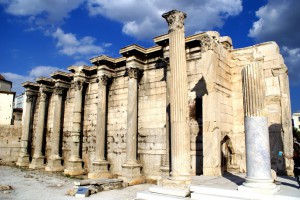 On Areos street, just opposite the entrance to the Monastiraki metro station, lies the archaeological site of Hadrian’s Library. Though only a few remnants remain intact, many other valuable findings are being unearthed in this ongoing excavation. Described in written detail by Pausanias the traveller in the 2nd century A.C., the Library was comprised of 100 columns, supporting a gilded roof, and was decorated with precious alabaster artifacts.
On Areos street, just opposite the entrance to the Monastiraki metro station, lies the archaeological site of Hadrian’s Library. Though only a few remnants remain intact, many other valuable findings are being unearthed in this ongoing excavation. Described in written detail by Pausanias the traveller in the 2nd century A.C., the Library was comprised of 100 columns, supporting a gilded roof, and was decorated with precious alabaster artifacts.
Today the visitor can see the pediments of the internal yard columns, the four, seven-meter-long forming alleys, the foundations, some two-story walls near the southern perimeter, remnants of a pavilion in the centre of the yard, and, to the north-west, the Library entrance, framed by seven Corinthian era columns. The entrance to the site is on Areos street., opposite the exit of the Monastiraki Metro station.
Source: www.athensattica.gr
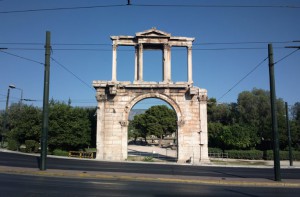 Philhellene Roman Emperor, Hadrian (117-138 μ.Χ.), founded a new neighbourhood near the eastern border of ancient Athens. To honour him, the Athenians named it Adrianopolis, and in 131-132 A.C., built an arch of Pentelic marble, leading from the old city into the new. Situated near the Temple of Olympian Zeus, the arch remains intact and in excellent condition, and is one of the most recognizable, and photographed landmarks of the city.
Philhellene Roman Emperor, Hadrian (117-138 μ.Χ.), founded a new neighbourhood near the eastern border of ancient Athens. To honour him, the Athenians named it Adrianopolis, and in 131-132 A.C., built an arch of Pentelic marble, leading from the old city into the new. Situated near the Temple of Olympian Zeus, the arch remains intact and in excellent condition, and is one of the most recognizable, and photographed landmarks of the city.
In the late 18th century, the arch served as part of the city’s defensive wall, known at the time as the Haseki wall. It was later named the “Gate of the Princess” or the “Arch Gate.” Today it stands in the very heart of modern Athens, a stunning marble monument to the days of glory in ancient Athens.
Source: www.athensattica.gr
Visible to the southwest of the Acropolis, is the Temple of Olympian Zeus. Construction began in the 6th century B.C., during the rule of the tyrant of Athens, Peisistratus. But construction was halted throughout the era of the Athenian Democracy, as the temple was deemed a symbol of tyranny. Later, during the Hellenistic period, there was an attempt to resume construction, by Antiochus IV Epiphanes, King of Syria, but work was once again terminated when he died. Still only half-finished, serious damage was inflicted on the Temple by Lucius Cornelius Sulla, who sacked of Athens in 86 B.C.
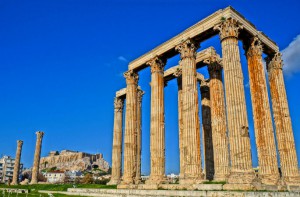 It was not until the accession of the Philhellene Emperor, Hadrian, in 131 A.C. that the project was finally completed, following its original design. The Temple was abandoned and badly damaged again, during the Herulian sack of Athens in the 3rd century, when most of the columns were torn down, to be used as building materials. Sixteen columns remain today, fifteen of them still standing and one lying on the ground, where it fell during a storm in 1852. Apart from the main temple, the site also contains remnants from Roman thermae, Classical era residences, foundations of an Early Christian basilica, and parts of the city’s Roman fortifications.
It was not until the accession of the Philhellene Emperor, Hadrian, in 131 A.C. that the project was finally completed, following its original design. The Temple was abandoned and badly damaged again, during the Herulian sack of Athens in the 3rd century, when most of the columns were torn down, to be used as building materials. Sixteen columns remain today, fifteen of them still standing and one lying on the ground, where it fell during a storm in 1852. Apart from the main temple, the site also contains remnants from Roman thermae, Classical era residences, foundations of an Early Christian basilica, and parts of the city’s Roman fortifications.
Source: www.athensattica.gr
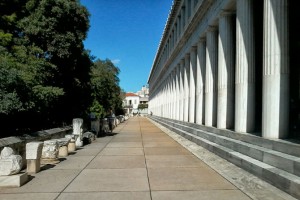 The impressive Stoa of Attalos, is the restored building located on the eastern side of the Ancient Agora. Now protected as part of the archaeological site, the stoa was named after King Attalus II of Pergamon, who gave it to the city as a gift. Erected over a span of twenty-one years, between 159 and 138 B.C., the stoa was, at the time, the longest free-standing, roofed building in the city. Built to house the city’s commercial activities, the two-story structure was 120 meters long, with 21 stores and workshops.
The impressive Stoa of Attalos, is the restored building located on the eastern side of the Ancient Agora. Now protected as part of the archaeological site, the stoa was named after King Attalus II of Pergamon, who gave it to the city as a gift. Erected over a span of twenty-one years, between 159 and 138 B.C., the stoa was, at the time, the longest free-standing, roofed building in the city. Built to house the city’s commercial activities, the two-story structure was 120 meters long, with 21 stores and workshops.
With walls constructed entirely of limestone, the doorjambs, doors, staircases, columns and wall studs were all made of white Pentelic marble. Destroyed during the Herulian sack of Athens in 267 A.C., the Stoa’s remnants were later used to build the Late Roman fortification wall. Rebuilt in the 1950s by the American Archaeological Institute, the Stoa rose again, this time to house the Museum of the Ancient Agora.
Source: www.athensattica.gr
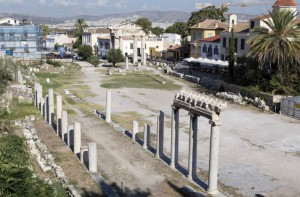 Situated in the historic Athenian neighbourhoods of Plaka and Monastiraki, the Roman Forum was built during the rule of the Roman Emperor Augustus, between 19 and 11 B.C. to house the city’s trade center. Later, under the rule of Emperor Hadrian, the Forum was restructured and expanded, with its main yard being paved. Major landmarks in the area include the Horologion, built by Andronicus of Cyrrhus (also known as “Tower of the Winds”), and the Forum’s western gate, which has been well preserved.
Situated in the historic Athenian neighbourhoods of Plaka and Monastiraki, the Roman Forum was built during the rule of the Roman Emperor Augustus, between 19 and 11 B.C. to house the city’s trade center. Later, under the rule of Emperor Hadrian, the Forum was restructured and expanded, with its main yard being paved. Major landmarks in the area include the Horologion, built by Andronicus of Cyrrhus (also known as “Tower of the Winds”), and the Forum’s western gate, which has been well preserved.
The most significant feature distinguishing the Forum from the classic agora, is that the Forum was built primarily for trade. After the city’s destruction during the Herulian invasion in the late 3rd Century A.C., trade activities were conducted within the confines of the Forum, it’s Roman walls offering protection. Eventually, this location evolved into the administrative centre of Athens. But nothing is ever permanent, and over the centuries, the Byzantine era, followed by the Frankish and Ottoman occupations again changed the Forum; Christian churches, new houses and workshops rose, followed later by the Fetihie mosque, all built at the site. But trade activities, such as the wheat market, were preserved.
Source: www.athensattica.gr
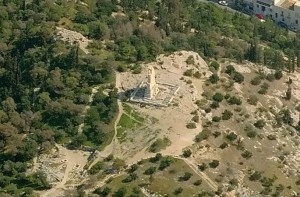 Philopappos Hill, or “Mousseion Hill” as it was known in antiquity, is situated northwest of the Acropolis rock. Named after Philopappos, grandson of Antiochus IV Epiphanes, King of Syria, the hill was honored with the title of this Roman consul, who was a great lover of the city. Declared an Athenian citizen in the late 1st Century, Philopappos was bestowed with various offices.
Philopappos Hill, or “Mousseion Hill” as it was known in antiquity, is situated northwest of the Acropolis rock. Named after Philopappos, grandson of Antiochus IV Epiphanes, King of Syria, the hill was honored with the title of this Roman consul, who was a great lover of the city. Declared an Athenian citizen in the late 1st Century, Philopappos was bestowed with various offices.
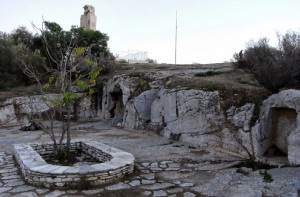 During excavations by archaeologist Konstantinos Travlos, he uncovered an ancient monument that turned out to be the actual mausoleum of Philopappos. Only one wall of the Mausoleum remains today, showing relief scenes from Philopappos’ life. An inscription was also saved. Due to its numerous decorative elements, it is believed that this monument is one of lesser import than others of Classical and Hellenistic Athens.
During excavations by archaeologist Konstantinos Travlos, he uncovered an ancient monument that turned out to be the actual mausoleum of Philopappos. Only one wall of the Mausoleum remains today, showing relief scenes from Philopappos’ life. An inscription was also saved. Due to its numerous decorative elements, it is believed that this monument is one of lesser import than others of Classical and Hellenistic Athens.
Source: www.athensattica.gr
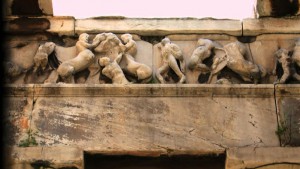 The Temple of Hephaestus at the Ancient Agora is the best preserved and restored ancient temple in Athens. Built during the Golden Age of Athens in 450 B.C., it is believed to have been constructed, either by Iktinos or, possibly by someone else, whose name was lost to antiquity. But based on similarities in design, it has been surmised that the architect who built the Temple of Hephaestus, more than likely designed the identical temples of Poseidon in Sounion, Nemessis in Ramnous, and Ares in Menidi. It is interesting to note that this temple was initially dedicated to the hero, Thesseus, who also named the area we now call Athens.
The Temple of Hephaestus at the Ancient Agora is the best preserved and restored ancient temple in Athens. Built during the Golden Age of Athens in 450 B.C., it is believed to have been constructed, either by Iktinos or, possibly by someone else, whose name was lost to antiquity. But based on similarities in design, it has been surmised that the architect who built the Temple of Hephaestus, more than likely designed the identical temples of Poseidon in Sounion, Nemessis in Ramnous, and Ares in Menidi. It is interesting to note that this temple was initially dedicated to the hero, Thesseus, who also named the area we now call Athens.
Video by fabdrone
When Christianity prevailed, the Doric temple of Hyphaestus was converted into a church in honor of Saint George. During the Ottoman occupation, the Athenians kept the church closed in order to avoid its conversion into a mosque by the Ottomans. Opening its doors only when celebrating their Saint’s name day, the Athenians called this church “Saint George Akamatis” (Lazy), to point out this peculiarity.
Source: www.athensattica.gr
Located near the Acropolis on Tripodon Street, the Choragic Monument of Lysicrates was erected by the choregos Lysicrates, a wealthy patron of musical performances at the Theater of Dionysus. According to the inscription carved on the monument’s epistylion, Lysicrates built the monument to commemorate the award of first prize in 335/334 B.C.
Circular in design, and anchored on a square podium of limestone, the centerpiece is surrounded by six elaborate, Corinthian-style columns made of white Pentelic marble.
 Its frieze sculptures depict episodes from the myth of Dionysus, and it is crowned by a monolithic roof that supports the choragic tripod. This ancient monument, also called the “Lantern of Diogenes”, by contemporary Athenians, was arbitrarily enclosed by the nearby French Catholic Capuchin monastery during the 17th century, being used as a reading chamber and for storing books. In 1821, the convent was destroyed during the battles for independence. But the monument survived, and is considered by many to be the best preserved sample of an ancient choragic monument in existence. It now occupies the centre of Lysicratous square, evoking admiration from passers-by.
Its frieze sculptures depict episodes from the myth of Dionysus, and it is crowned by a monolithic roof that supports the choragic tripod. This ancient monument, also called the “Lantern of Diogenes”, by contemporary Athenians, was arbitrarily enclosed by the nearby French Catholic Capuchin monastery during the 17th century, being used as a reading chamber and for storing books. In 1821, the convent was destroyed during the battles for independence. But the monument survived, and is considered by many to be the best preserved sample of an ancient choragic monument in existence. It now occupies the centre of Lysicratous square, evoking admiration from passers-by.
Source: www.athensattica.gr
 The world-famous Acropolis, the “sacred rock,” is a fortified hill towering 156 meters high in the heart of Athens, its summit home to one of the most important historical building complexes ever constructed by man, awe-inspiring symbols of humankind’s quest for balance, reason, justice and democracy, ageless reminders that this is the birthplace of western civilization. It also reminds us that the Greek civilization has thrived here since the prehistoric era. Used regularly by the ancient Athenians since the 3rd millennium B.C., traces have been uncovered here, dating as far back as the Mycenaean era, as well as traces of archaic-era temples.
The world-famous Acropolis, the “sacred rock,” is a fortified hill towering 156 meters high in the heart of Athens, its summit home to one of the most important historical building complexes ever constructed by man, awe-inspiring symbols of humankind’s quest for balance, reason, justice and democracy, ageless reminders that this is the birthplace of western civilization. It also reminds us that the Greek civilization has thrived here since the prehistoric era. Used regularly by the ancient Athenians since the 3rd millennium B.C., traces have been uncovered here, dating as far back as the Mycenaean era, as well as traces of archaic-era temples.
Today, the visitor can admire amazing 5th Century architecture like the Parthenon, the Erechteion, the Propylaea, and the Temple of Nike Apteros.
 The Acropolis was used during later years for religious, administrative, and even defensive purposes. In fact, the monuments have suffered substantial damage due to war; in 1687 the Acropolis was bombed by Morozzini, and Kioutahi Pasha’s siege of 1826 to 1827 did further damage. But these interventions from foreign conquerors and religious fanatics did not diminish, in the least, the stunning beauty or cultural significance of these monuments. The Parthenon, a monument of Global Heritage [Unesco 1987], is today the most visited sight in Greece, attracting millions of visitors each year.
The Acropolis was used during later years for religious, administrative, and even defensive purposes. In fact, the monuments have suffered substantial damage due to war; in 1687 the Acropolis was bombed by Morozzini, and Kioutahi Pasha’s siege of 1826 to 1827 did further damage. But these interventions from foreign conquerors and religious fanatics did not diminish, in the least, the stunning beauty or cultural significance of these monuments. The Parthenon, a monument of Global Heritage [Unesco 1987], is today the most visited sight in Greece, attracting millions of visitors each year.
Source: www.athensattica.gr







